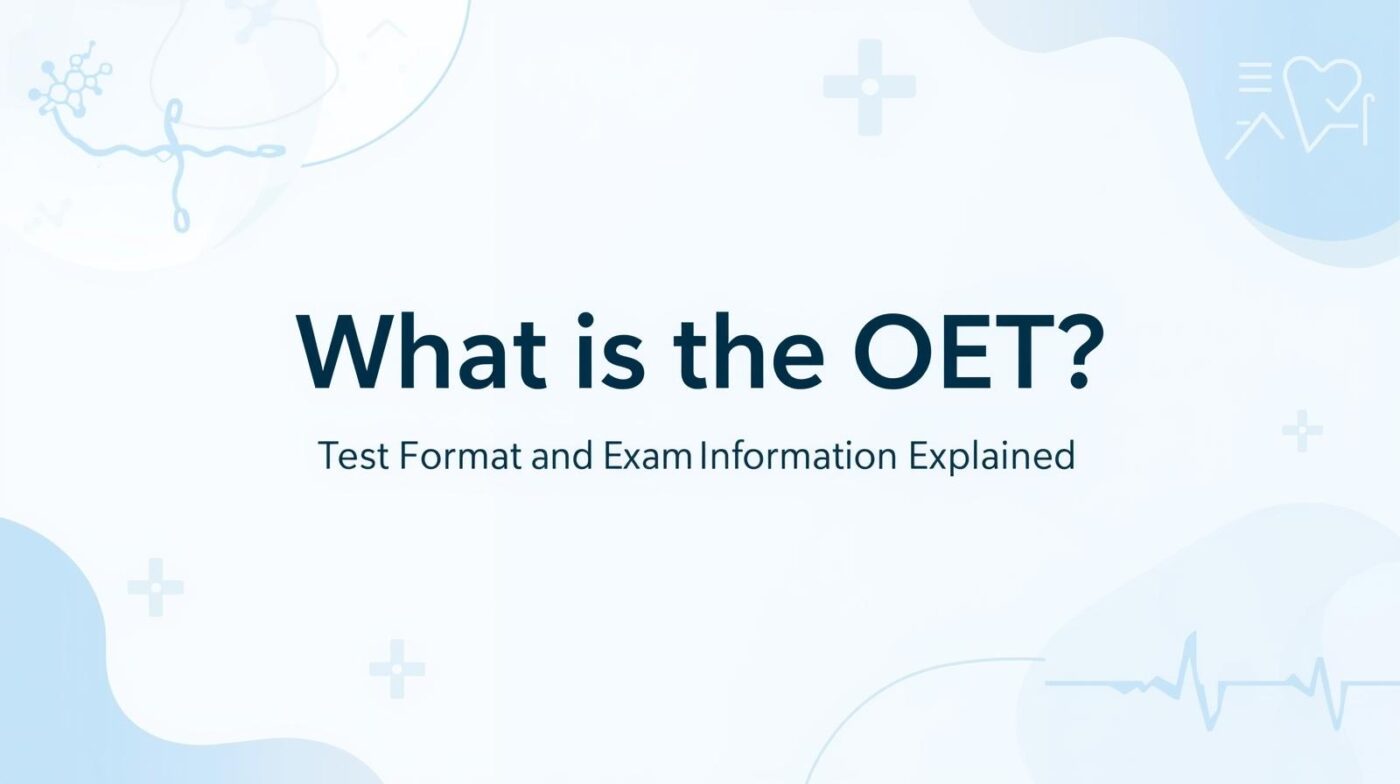OET Strategies
What Is the OET? Test Format and 2026 Exam Information Explained
The Occupational English Test — or OET — is a global English exam made just for healthcare professionals.
It focuses on real-life medical communication, not abstract grammar or textbook English.
In this article, we’ll look at what OET is, how it’s structured, and what’s new for the 2026 exam.
Check the Test Content
- Name: Occupational English Test (OET)
- Purpose: Evaluates healthcare-specific communication in English
- Structure: Listening / Reading / Writing / Speaking (four skills)
- Scoring: Each sub-test is scored 0–500 in 10-point increments.
- Many regulators set 350 (Grade B) as the operational benchmark.
Official website: https://www.occupationalenglishtest.org/
Time limits (approx.)
- Listening: ~40 minutes, 3 parts, 42 questions
- Reading: 60 minutes (Part A = 15 minutes fixed, Parts B+C = 45 minutes)
- Writing: 45 minutes
- Speaking: ~20 minutes
Listening and Reading are common to all test takers.
Writing and Speaking are profession-specific, so preparation should match your registration pathway (e.g., Medicine, Nursing, Pharmacy, etc.).
For many candidates, Reading and Listening feel more challenging, while Speaking and Writing may be relatively quicker to stabilize—but OET still demands a high level of practical language ability.
Instead of comparing “difficulty” directly with general tests, think of OET 350 (B) as a high, practice-ready standard that many authorities equate with advanced performance.
Supported Professions
OET covers multiple healthcare professions (e.g., Medicine, Nursing, Dentistry, Dietetics, Pharmacy, Optometry, Occupational Therapy, Veterinary Science, Podiatry, Physiotherapy, Speech Pathology, Radiography).
Reading/Listening are shared; Writing/Speaking tasks reflect the professional context.
Where Is OET Recognized?
OET is recognized by multiple countries and organizations—notably the UK, USA, Australia, New Zealand, Canada, Ireland, Singapore, and others.
Because recognition evolves, always verify your target regulator or institution via the official “Who Recognises OET” list:
Ref: https://oet.com/test/who-recognises-oet
Submission rules differ: Some authorities require all sub-test scores from a single sitting; others may allow combining across sittings.
The United States and OET (IMG Focus)
- Physicians (IMGs):
After the discontinuation of USMLE Step 2 CS, ECFMG accepts OET Medicine to satisfy its communication skills requirement. You must achieve L/R/S ≥ 350 and W ≥ 300 in a single sitting (no “mix-and-match” across attempts).
See ECFMG Pathways: https://www.ecfmg.org/certification-pathways/oet.html - Nurses:
Multiple U.S. Boards of Nursing accept OET, but requirements vary by state, and alternatives (IELTS/TOEFL) may also be permitted. Check the target state Board of Nursing directly for the latest policy and minimum scores.
Section-by-Section Difficulty & Tips
Listening
- ~40 minutes, 3 parts, 42 questions; audio plays once.
- Part A: Patient consultations—extract key clinical information quickly.
- Part B: Short workplace extracts—choose the best option.
- Part C: Longer presentations/interviews—answer MCQs.
Building stable accuracy in Part A is often pivotal.
Reading
- 60 minutes total, 3 parts, 42 questions
- Part A (15 min, 20 Qs): Rapid extraction from four short texts.
- Part B: Six workplace texts—identify main point/purpose.
- Part C: Two longer texts—global meaning and inference.
Time management and evidence-based selection are crucial.
Writing
- 45 minutes. A profession-specific task, typically a clinical letter (e.g., referral or discharge). Assessors value purpose, audience, and the clinical relevance and clarity of information.
Speaking
- ~20 minutes. Role-plays with an interlocutor (patient, carer, or client, depending on profession). Assessment focuses on interactional competence—clear explanations, signposting, empathy, clarification, and appropriate tone.
Test Logistics and Booking (2026)
Test Dates & Booking
- OET on Computer / OET@Home typically offers booking Monday–Saturday (availability varies by location, capacity, and season). Paper-based sessions follow separate schedules.
- Always check live availability via your OET account before planning travel.
Start here: https://oet.com/test/book-a-test
Centre availability may change. Use the official booking journey and, where applicable, Prometric to confirm the most up-to-date locations and seat availability.
Fees & Currency
- The full OET fee is listed by OET at the time of booking (often shown as AUD for OET on Paper and USD for OET on Computer / OET@Home in some regions).
- Your final charge may vary due to currency and payment processor.
OET@Home (Remote Proctoring)
- Eligibility depends on your physical location at the time of testing and meeting system requirements.
- Windows or macOS can be used if they meet current technical specs (screen resolution, OS versions, browser, etc.). Review current requirements via the OET/Prometric guidance during booking.
OET vs. IELTS (Quick Comparison)
- Specialization: IELTS tests general academic/professional English; OET targets healthcare settings and tasks.
- Frequency & access: OET on Computer / OET@Home offers frequent booking windows (often Mon–Sat); IELTS schedules vary by provider/location.
- Score benchmarks: There is no official one-to-one conversion between OET and IELTS/TOEFL. Many healthcare regulators operationally set OET 350 (Grade B) as the benchmark; check your authority’s latest rules rather than relying on “equivalency” charts.
Study with OET BANK
Stop wasting time comparing OET materials.
With OET BANK, you get:
- Premium-quality OET materials, built by professionals
- A focused, efficient study path — no unnecessary content
- A system designed to help you pass OET once — without trial and error
If you want to prepare properly and pass with confidence,
you don’t need to look anywhere else.
Pick your materials and start today — with OET BANK.




